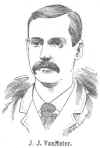it runs down the north slope of the north Solomon, empties in at Lenora.
He made actual settlement on the claim in the spring of 1872 but did not file at the United States land office until 1875.
He has made Norton county his home ever since. He followed hunting and trapping until the game left; he then engaged in farming and stock raising which occupation he has followed continually ever since.
He remembers when George N. Kingsbury visited his ranch on Elk Creek in 1873; and claims to have killed the last wild buffalo killed in the county in 1875.
The first settler he ever met in the county was I. N. Cope, in August, 1872; he was hunting his team which had strayed away; he came down the Prairie Dog to Cope's
cabin; Mrs. Cope got him some dinner, which he says he will remember as long as he lives.
She served him up some ham and eggs, the first he had eaten in three years.
Mrs. Cope was the first white woman he had seen in the county; this was also the first meal he had eaten at a table in many years.
He learned from Cope that there were some settlers on the Prairie Dog, although at that time there was but one west of Cope's farm.
Jule was well acquainted with all the buffalo hunters, except Ame Cole, although he had hunted for days within the sound of his gun, he never met him.
Among the names of the hunters that Jule often names is Charley Feast, John Schoonover, John Humphrey, James Forbes, Billy Hillmon, John Kelly, Ab Wrager, Hank Gordon, Dan Castilo, Billy Street, Sol Reese, Ed O'Brien, Joe Fautz (California Joe) Sol Peak, Morg Hansen, Shelby D. Reed and Chas. Stowell; he speaks highly
of Chas. Stowell, says he was one of the most congenial men he ever met, always in a good humor and ready to do his part.
He used a small Maynard rifle and was a splendid shot. Among his many friends none regretted his death (which occurred in the Custer massacre) more than J. J. Van Meter.
Jule sold  his land on Elk Creek in 1875 to Bill Harmon and located on the
Prairie Dog in August of 1876. He married Celestia, daughter of Nathan
Gray; they now have five children, three girls and two boys. He never was a candidate for any office and never had a law suit in his life.
Since the buffalo grass has run out and stock does not winter without hay and grain he is keeping his cattle in northwestern Nebraska.
For the last year or two he spends most of his time with his stock but his family remain on the home ranch west of Oronoque which he, of course calls home.
In speaking of his biography he says the most pleasant memories he has, run back to the early seventies during his experience as a hunter and trapper, and he hopes his biography will be read by his friends of the range and early settlers with the same kindly feeling for him that he still retains for them.
In the list of early settlers who came here when boys without property none have accumulated more property than he, although he was here during the hard times and crop failures and met with many reverses and discouragements he never lost hope and has at this time stock and land enough to make him wealthy. his land on Elk Creek in 1875 to Bill Harmon and located on the
Prairie Dog in August of 1876. He married Celestia, daughter of Nathan
Gray; they now have five children, three girls and two boys. He never was a candidate for any office and never had a law suit in his life.
Since the buffalo grass has run out and stock does not winter without hay and grain he is keeping his cattle in northwestern Nebraska.
For the last year or two he spends most of his time with his stock but his family remain on the home ranch west of Oronoque which he, of course calls home.
In speaking of his biography he says the most pleasant memories he has, run back to the early seventies during his experience as a hunter and trapper, and he hopes his biography will be read by his friends of the range and early settlers with the same kindly feeling for him that he still retains for them.
In the list of early settlers who came here when boys without property none have accumulated more property than he, although he was here during the hard times and crop failures and met with many reverses and discouragements he never lost hope and has at this time stock and land enough to make him wealthy.
In July, 1873, Jule Van Meter, Frank Van Horn and W. D. Street started out on a buffalo hunt.
When on the divide northwest of Clayton they saw a small bunch of buffalo lying on the prairie.
Jule left the wagon to kill one; he crawled up to within gun shot of them and fired killing it.
All at once every spear of grass in sight appeared to turn into an Indian.
The Indians had the herd completely surrounded, was just ready to swoop down upon them when Jule fired.
They came from all directions, every ravine for miles around appeared to be full of Indians on horseback.
They surrounded the herd and killed them all before they had run a
|